#biodiversity win
Text
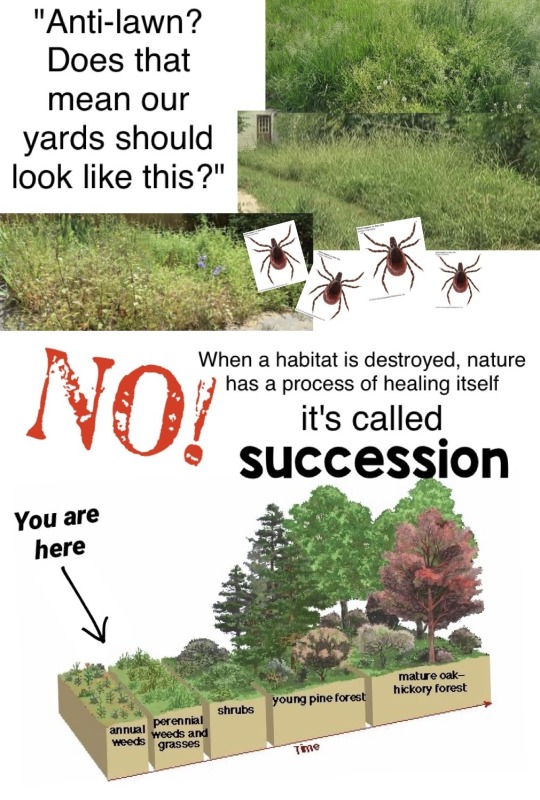
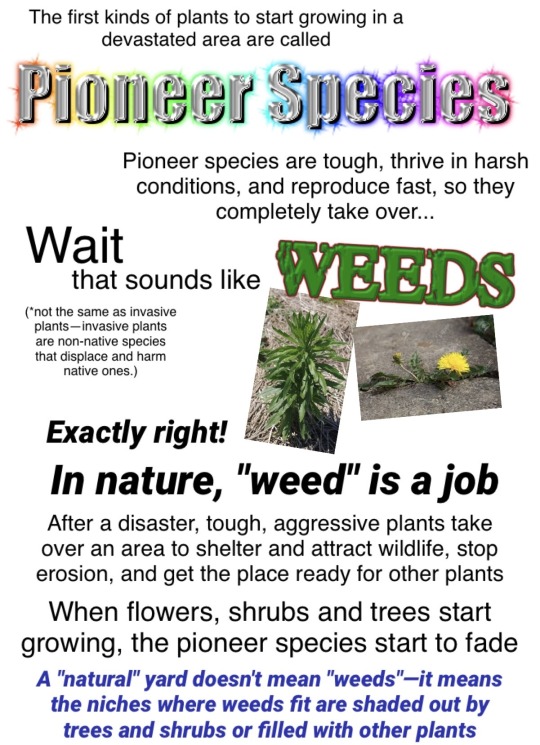
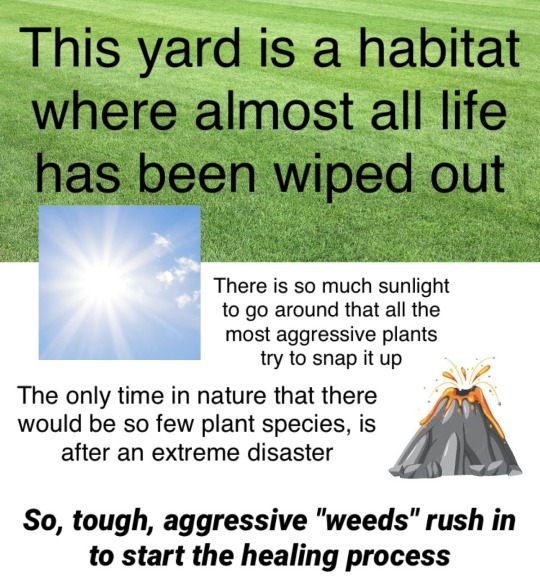
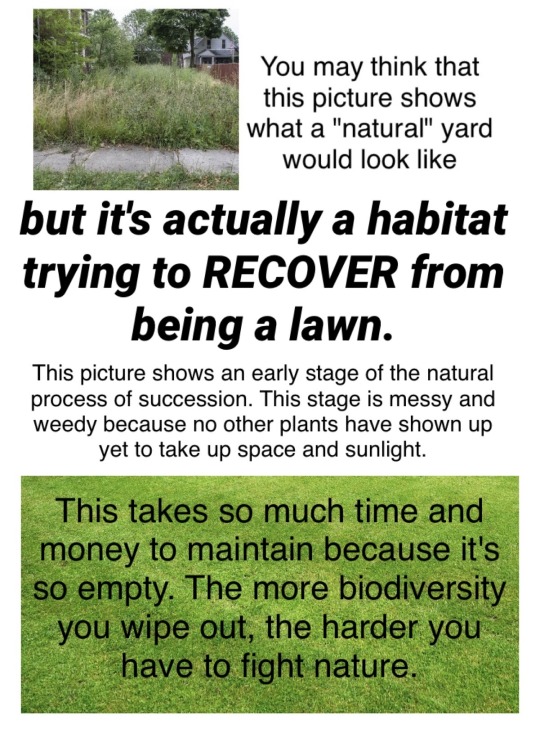


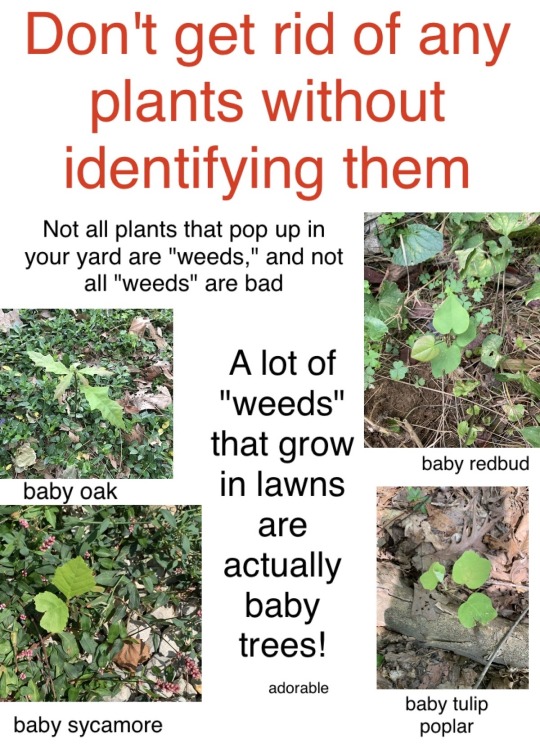
I...tried to make a meme and got carried away and made A Thing that is like partially unfinished because i spent like 3 hours on it and then got tired.
I think this is mostly scientifically accurate but truth be told, there seems to be relatively little research on succession in regards to lawns specifically (as opposed to like, pastures). I am not exaggerating how bad they are for biodiversity though—recent research has referred to them as "ecological deserts."
Feel free to repost, no need for credit
#random#ecology#shitpost#sorta#gardening#plants#lawn alternatives#anti lawn#pro biodiversity#biodiversity win#bugs tw#ticks
180K notes
·
View notes
Text
sv5 | that lavender haze

summary: [ florist!sebastian vettel x f!driver!reader — social media au ] your florist husband spoils you with his creations
faceclaim: phoebe tonkin
author’s note: seb the love of my life <3
[ masterlist / guidelines / lola's masterlist / series masterlist ]




liked by sebastianvettel, lewishamilton, mercedesamgf1 and 35,201,234 others
yourusername catching the waves 🏄🏻♀️
view comments
sebastianvettel Ich liebe dich 🥰
↪ yourusername can't wait to be home with you again 💗
ausgp can we keep you down under please? 🦘
↪ f1mia back off 🦅🇺🇸
user mother AND mommy omg
mickschumacher can you teach me how to surf instead 🙏 lewishamilton doesn't understand that not everyone is naturally talented at everything
↪ lewishamilton i don't know what to tell you, mate 😂 keep calm and keep your balance, it's all chill
↪ mickschumacher easy for you to say 🙄 you're not the one drinking seawater every five minutes
yourusername has added to their story




liked by yourusername, mickschumacher, charles_leclerc and 124,129 others
tagged: yourusername
sebastianvettel Welcome home yourusername ❤️ the flowers missed you and so did I 😉
view comments
user i love how y/n's husband's instagram is basically just a fanpage for her 😂
↪ user nah you can't forget the flowers ‼️
↪ user seb loves two things in life and they're his flowers and his wife 😌
user i don't even go here but i'm all for the golden retriever and black cat vibes 🤭
mickschumacher seb i have a bee problem in my backyard...
↪ charles_leclerc you know you could just text him right 🙃
↪ mickschumacher he checks his phone once every three months if your name isn't y/n l/n-vettel 💀
↪ sebastianvettel and I'm not ashamed of it 😄 but what can I help you with?
↪ mickschumacher a colony of bees moved into my garden 😅 i don't mind them but is there anything i should watch out for?
↪ sebastianvettel As long as they're not being overly aggressive you shouldn't have any problems 👍 keep me updated though
↪ mickschumacher thanks seb you're a lifesaver 😊
yourusername thanks for the flowers schatz 😘
↪ user ugh they're so Parents 😭
liked by charles_leclerc
↪ user charles liked your comment 😂 i guess even the drivers agree
↪ landonorris you didn't hear it from me but seb and y/n are the unofficial official grid parents



liked by mickschumacher, lewishamilton, yourusername, and 23,109,234 others
tagged: sebastianvettel
mercedesamgf1 We have a special guest this weekend at the #JapaneseGP 🐝 sebastianvettel is here at Suzuka to promote biodiversity and build some bee hotels with the drivers 💪
view comments
charles_leclerc Appreciated the art tips 😉
user this man 😭 "what do you think about this weekend's race?" "well obviously my wife is going to win everything"
↪ user as he should honestly
↪ user when you're in a "being a wife guy" competition and your opponent is sebastian vettel 💀
kevinmagnussen Thanks a lot Seb 😂 the kids want beehives now!
↪ sebastianvettel Glad to know that someone was listening when I was giving my talk about the role that bees play in our ecosystem 😔
↪ landonorris in my defence someone brought cookies and i was hungry...
↪ sebastianvettel you are 24 years old, Lando
↪ user why can i feel seb's disappointment through an instagram comment 😭
yourusername sometimes i wonder if he'd leave me for his bees 😂
↪ lewishamilton don't worry, you can crash on my couch if he does. roscoe needs a permanent babysitter
↪ yourusername two decades of friendship and that's all you see me as?
↪ lewishamilton let me by during the grand prix and i'll think about it
↪ yourusername mercedesamgf1 i'm telling toto
↪ sebastianvettel I would never leave you for bees, liebling. Clean energy, on the other hand...



liked by sebastianvettel, lewishamilton, susie_wolff and 132,293,402 others
tagged: sebastianvettel
yourusername Happy anniversary, my love 💐 12 years and counting
view comments
user the bouquet emoji because he's a florist omg 🥹
user my favorite thing ever is how 5-time wdc y/n l/n-vettel's husband is Just Some Guy who's completely smitten with his wife and makes her all the bouquets she could ever want 😭
↪ user they're like cottagecore addams 😩 i adore them so much
↪ user COTTAGECORE ADDAMS HELP 🤣🤣🤣
susie_wolff Congratulations and our best wishes!
↪ yourusername thank you ❤️😊 the same to you and toto!
sebastianvettel I'm the luckiest man in the world to be able to call you my wife and partner 💗 You're P1 forever, especially in my heart
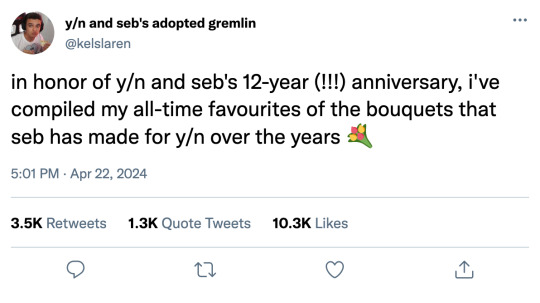


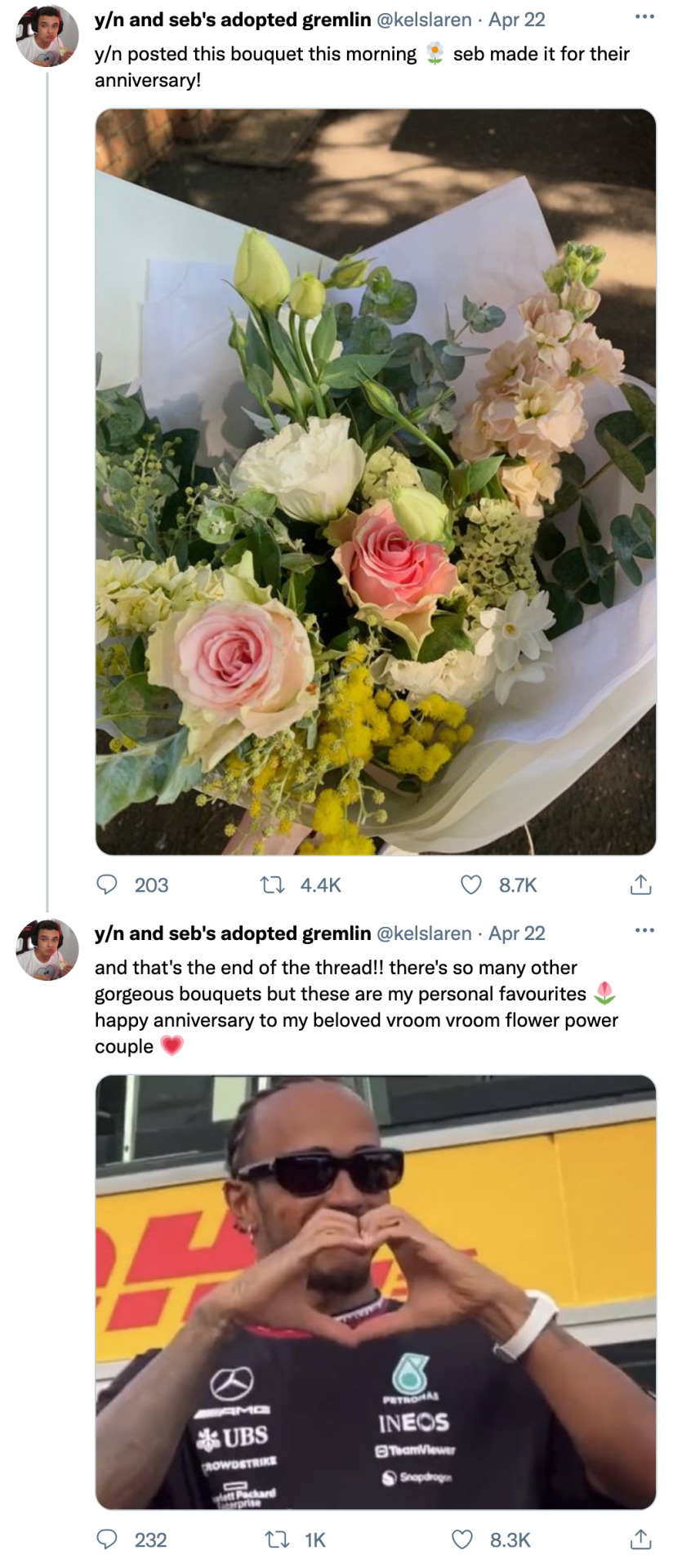

likes and reblogs are appreciated!
taglist: @scenesofobx @vellicora @boiohboii @julesbabey @flannelforthetoads @misartymis
#solwriting#f1 x reader#formula 1 x reader#formula one x reader#formula 1#f1#f1 fanfic#formula 1 fanfic#formula 1 x you#f1 social media au#f1 imagine#f1 smau#sebastian vettel#sebastian vettel x reader#sebastian vettel x you#sebastian vettel imagine#sebastian vettel fanfic
1K notes
·
View notes
Text
Note: Reasons to Be Cheerful has had weirdly huge formatting issues for the past six or so months, so if that version is a mess, this link should work better.
"Florida Power & Light Company (FPL), the Sunshine State’s largest power utility, employs all the people you might expect: electricians, lineworkers, mechanical engineers — and a few you might not. For over 40 years, the company has kept a team of wildlife biologists on staff. Their task? Monitoring the giant carnivorous reptiles that reside in one of the state’s nuclear power plants.
Saving the American Crocodile
What sounds like a low-budget creature feature is actually a wildly successful conservation story. It goes like this: In 1975, the shy and reclusive American crocodile was facing extinction. Over-hunting and habitat decline caused by encroaching development had pushed its numbers to a record low. By 1975, when it was listed as endangered under the Endangered Species Act, there were only 200 to 300 left.
Three years later, in 1978, workers at the Turkey Point nuclear power plant in Homestead, Florida happened upon something that must have made them gasp: a crocodile nest along one of the plant’s 5,900-acre “cooling canals.” Rather than drive the crocs away — perhaps the easiest solution — FPL hired a team of biologists and implemented a Crocodile Management Plan. Its goal was unconventional: provide a suitable habitat for the crocs within the workings of the nuclear power plant, allowing both to coexist.
Over the course of the next 30 years, FPL’s wildlife biologists monitored nests, tagged hatchlings and generally created a hospitable environment for the reptiles. As it turned out, the plant’s cooling canals provided an ideal habitat: drained earth that never floods on which to lay eggs directly adjacent to water. Over the years, more and more crocs made the cooling canals home. By 1985, the nests at Turkey Point were responsible for 10 percent of American crocodile hatchlings in South Florida. In 2007, the U.S. Fish and Wildlife Service downgraded the American crocodile’s status from endangered to threatened, singling out FPL for its efforts.
The program continues to this day. To date, biologists have tagged some 7,000 babies born at the plant. In 2021, there were a record-setting 565 crocodile hatchlings at the Turkey Point facility.
"Reconciliation Ecology"
Turkey Point’s efforts are an example of what is known in the conservation world as “reconciliation ecology.” Rather than create separate areas where nature or animals can thrive in isolation from humans, reconciliation ecology suggests that we can blend the rich natural world with the world of human activity. Michael Rosenzweig, an emeritus professor of ecology and evolutionary biology at the University of Arizona, was a leading force in establishing this concept. The author of Win-Win Ecology: How the Earth’s Species can Survive in the Midst of Human Enterprise, Rosenzweig has pointed out that although human encroachment has typically been considered a threat to biodiversity, the notion that the world must be either “holy” or “profane,” ecologically speaking, is simply not true.
“In addition to its primary value as a conservation tool, reconciliation ecology offers a valuable social byproduct,” writes Rosenzweig in his first chapter. “It promises to reduce the endless bickering and legal wrangling that characterize environmental issues today.”
-via Reasons to Be Cheerful, May 5, 2022. Article continues below. All headings added by me for added readability.
Dr. Madhusudan Katti, an associate professor in the Department of Forestry and Environmental Resources at North Carolina State University, was inspired by Rosenzweig when he did his postdoc at Arizona State. Katti has now been in the field of reconciliation ecology for two decades and teaches classes on the subject. “To me it’s finding solutions to reconciling human development with biodiversity conservation,” Katti says.
This common ground between development and conservation can be consciously planned, like FPL managing a crocodile habitat at a nuclear power plant or the state-sponsored vertical gardens and commercial farms on high-rise buildings in Singapore. Other examples include the restoration of the coral reef around an undersea restaurant in Eilat, Israel, or recent legislation in New York City requiring patterned glass on high-rise buildings, making windows more visible to migratory birds. Other planned examples of reconciliation ecology can be more individually scaled: a rooftop garden in an urban setting, modifying your garden to earn a “backyard bird habitat” certification from the Audubon Society, or even just mowing your lawn less often...
Reconciliation Ecology: Nature's Already Doing It Without Us
But there are countless examples of “accidental” incidents of reconciliation ecology, as well. One of Katti’s favorites is the kit fox of California’s San Joaquin Valley. “The kit fox was one of the very first species listed on the Endangered Species Act,” Katti says. Its decline was caused by habitat loss through agricultural and industrial development, as well as the extermination of the gray wolf population, which led to an increase in coyotes. So kit foxes adapted and moved to new habitats. One of these was the city of Bakersfield, California.
“Bakersfield, surrounded by oil pumps, would be the last place you’d expect to find an endangered species,” Katti says. But researchers think kit foxes have migrated to Bakersfield because they actually have more protection there from predators like coyotes and bobcats. “The kit foxes have figured out that if they can tolerate the human disturbance and live with people, then they are safer from all these other predators,” he says.
Living in the city has led to some interesting behavioral changes. In the wild, for instance, a female kit fox gives birth to her young and raises them by herself in a den. But in the city, researchers have observed multiple females raising their litters together in the same den. “It’s like a form of cooperative breeding,” Katti says. “That wouldn’t happen in the wild.” ...
The Big Picture: How We Think about Conservation
Reconciliation Ecology isn’t just we humans welcoming animals like crocodiles and foxes into our environments, though. It’s also living with nature in a way that most Western societies haven’t done since the Enlightenment. “In recent years, there’s been a recognition that the ‘fortress conservation’ model — keeping nature separated from humans and not thinking of or valuing human-inhabited landscapes — those ideas are outdated,” says Katti.
In fact, in Katti’s classes on reconciliation ecology, he embraces the notion of reconnecting people with their land if they have been unjustly separated from it. “The term reconciliation also applies to all the colonial legacies where both nature and people have been harmed,” Katti says. “For Indigenous communities, the harm done to ecosystems, it’s happened together. So you can talk about addressing both. That’s where a lot of my thinking is at the moment.”
A hopeful version of this sort of reconciliation is happening in California where colleagues of Katti’s who are tribal members are re-introducing “tribal burns” in some areas. Controlled burns have been a part of many Indigenous cultures for millenia, both as a way to prevent devastating forest fires, but also to encourage the growth of certain plants like hazel that are used for basket-weaving and other crafts.
“The notion that people don’t belong there and ‘let nature take care of itself’ doesn’t really work,” Katti says. “That’s the legacy of Western European Enlightenment thinking — a divide between human and nature. That is a real faulty view of nature. People have been part of the ecosystem forever.”
-via Reasons to Be Cheerful, May 5, 2022
#a bit older but still ongoing/relevant and still very cool#florida#crocodile#reptile#ecology#environment#sustainability#endangered species#united states#california#kit fox#nuclear power plant#reconciliation#colonialism#the enlightenment#conservation#human beings#good news#hope#urban ecology
1K notes
·
View notes
Text
Breaking news from Panama! 🟢
In a historic vote, the nation’s highest court today ruled the Minera Panamá mining contract for an open-pit mine unconstitutional, marking a WIN for biodiversity, local communities, and our planet.
Panama has an opportunity now to be a leader in safeguarding precious ecosystems and protecting biodiversity. This ruling champions the rights, voices, and well-being of local communities over profit-driven interests.
This victory is also a beacon of hope for our planet’s future. Safeguarding irreplaceable ecosystems like these is critical to combatting climate change and biodiversity loss. Congratulations to the people of Panama, who overwhelmingly rejected profit over planet. We continue to stand with you!
Video credits:
Collaboration between @duletvindigena @waguafilms @mullu.tv & Passu Creative Community
Indigenous Protester - TV indígena and waguafilms
Great Green Macaw - Hans Norelius, CC BY 2.0
Gemini's Dart Frog Jaime Culebras / @photowildlifetours
#PanamaTeQuieroVerde
#PanamáValeMásSinMinería
#panama#central america#latin america#abya yala#environmental justice#climate justice#ecology#anti imperialism#extractivism#neocolonialism#anti colonialism#indigenous rights#degrowth#i'm so happy for my country 😭❤️
522 notes
·
View notes
Text
Spock's World Inspired Holiday Card circa 1992
December 1992. Spock's World was among my favorite novels. I had just turned 19 years old that month. In keeping with the tradition of making holiday cards, that year I drew artwork inspired by a scene in Spock's World, the Star Trek novel by Diane Duane.
No computer. No printer. This was 1992. I drew it in pencil and darkened it with ink. The message was all hand lettered. My dad made copies of the artwork at his office. Each copy was colored by hand with colored pencils and crayons.
The image centers on the IDIC symbol, Infinite Diversity in Infinite Combination, a concept central to Vulcan philosophy. Diane Duane wrote the most beautiful passage in Spock's World that simply explained the meaning of IDIC. I copied the passage for the message inside the card. The IDIC symbol was surrounded by animals, plants, and other organisms representing the biodiversity of Earth.
The passage from Spock's World was from a scene where Surak was in the desert and saw the giant sandworm-like creature, referred to as the Underlier (called A'kweth or Tcha'besheh). Both beings paused and beheld one another, the Underlier and the Vulcan, in the vast desert under the light of T'Khut (called The Watcher), Vulcan's sister planet.
"How delightful to be so different from something. No need to understand them, particularly; that might come with time and would be an added delight. But it was enough to accept their difference, to celebrate just that without anything added. Creation, in itself, was joy, the difference was joy, the celebration of it was joy."
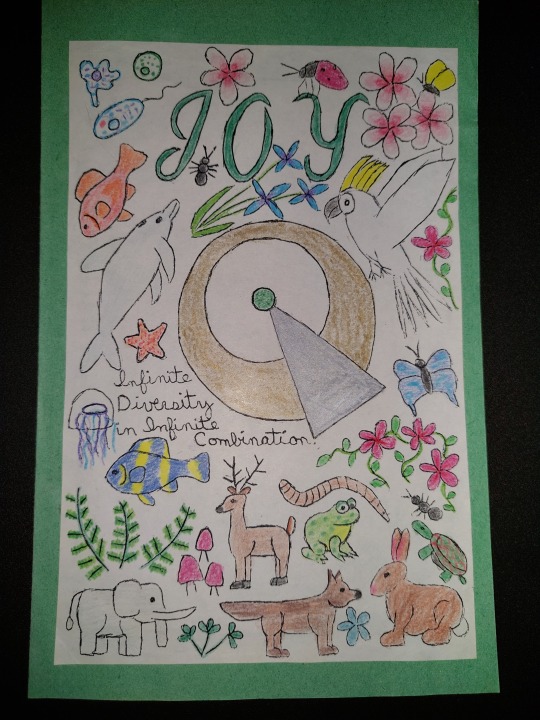
Front of card. Star Trek inspired greeting card artwork. Based on the novel Spock's World. Image features the Vulcan IDIC symbol and cartoon drawings of animals representing diversity. Created in 1992.

Inside of card. Star Trek inspired greeting card artwork. Based on the novel Spock's World. Image features a quotation from the novel representing diversity and the IDIC philosophy. Created in 1992.

Front and back of card. Star Trek inspired greeting card artwork. Based on the novel Spock's World. Image features the Vulcan IDIC symbol and cartoon drawings of animals representing diversity. Created in 1992. (Copyright Myers Cards 1992.)
The passage in the novel continued:
"There was nothing that could stand against that joy: sooner or later it would triumph. All evil, all death, was a tiny, fretting, posturing thing that knew its own defeat was coming, and it might rage and destroy as it liked. It was doomed. Celebration would win, was winning, had won now. Everything was one moment, and the moment was nothing but triumph and joy."
This resonated with my 18/19 year old self. This still resonates with me today. Oh, my heart! I cry for joy! Such beautiful ideas and words to live by!
Regretfully, I didn't credit the author on the card at the time. I assumed friends and family wouldn't care. It was yet another weird, cheap, homemade holiday card from their weirdo sister / niece / daughter / student / friend.
I hope you enjoy the amateur artwork and Diane Duane's message. Enjoy the diversity and differences. Embrace and embody IDIC.
Thank you, @dduane.
Peace and long life,
Amy
376 notes
·
View notes
Text
Excerpt from this Op-Ed from the New York Times:
At first glance, Xi Jinping seems to have lost the plot.
China’s president appears to be smothering the entrepreneurial dynamism that allowed his country to crawl out of poverty and become the factory of the world. He has brushed aside Deng Xiaoping’s maxim “To get rich is glorious” in favor of centralized planning and Communist-sounding slogans like “ecological civilization” and “new, quality productive forces,” which have prompted predictions of the end of China’s economic miracle.
But Mr. Xi is, in fact, making a decades-long bet that China can dominate the global transition to green energy, with his one-party state acting as the driving force in a way that free markets cannot or will not. His ultimate goal is not just to address one of humanity’s most urgent problems — climate change — but also to position China as the global savior in the process.
It has already begun. In recent years, the transition away from fossil fuels has become Mr. Xi’s mantra and the common thread in China’s industrial policies. It’s yielding results: China is now the world’s leading manufacturer of climate-friendly technologies, such as solar panels, batteries and electric vehicles. Last year the energy transition was China’s single biggest driver of overall investment and economic growth, making it the first large economy to achieve that.
This raises an important question for the United States and all of humanity: Is Mr. Xi right? Is a state-directed system like China’s better positioned to solve a generational crisis like climate change, or is a decentralized market approach — i.e., the American way — the answer?
How this plays out could have serious implications for American power and influence.
Look at what happened in the early 20th century, when fascism posed a global threat. America entered the fight late, but with its industrial power — the arsenal of democracy — it emerged on top. Whoever unlocks the door inherits the kingdom, and the United States set about building a new architecture of trade and international relations. The era of American dominance began.
Climate change is, similarly, a global problem, one that threatens our species and the world’s biodiversity. Where do Brazil, Pakistan, Indonesia and other large developing nations that are already grappling with the effects of climate change find their solutions? It will be in technologies that offer an affordable path to decarbonization, and so far, it’s China that is providing most of the solar panels, electric cars and more. China’s exports, increasingly led by green technology, are booming, and much of the growth involves exports to developing countries.
From the American neoliberal economic viewpoint, a state-led push like this might seem illegitimate or even unfair. The state, with its subsidies and political directives, is making decisions that are better left to the markets, the thinking goes.
But China’s leaders have their own calculations, which prioritize stability decades from now over shareholder returns today. Chinese history is littered with dynasties that fell because of famines, floods or failures to adapt to new realities. The Chinese Communist Party’s centrally planned system values constant struggle for its own sake, and today’s struggle is against climate change. China received a frightening reminder of this in 2022, when vast areas of the country baked for weeks under a record heat wave that dried up rivers, withered crops and was blamed for several heatstroke deaths.
144 notes
·
View notes
Text
Inside William’s Next Act: Tatler’s May issue goes behind the scenes as the Prince of Wales is rising above the noise — and playing the long game
The burden of leadership is falling upon Prince William, but as former BBC Royal Correspondent, Wesley Kerr OBE, explains in Tatler’s May cover story, the future king is taking charge
By Wesley Kerr OBE
21 March 2024
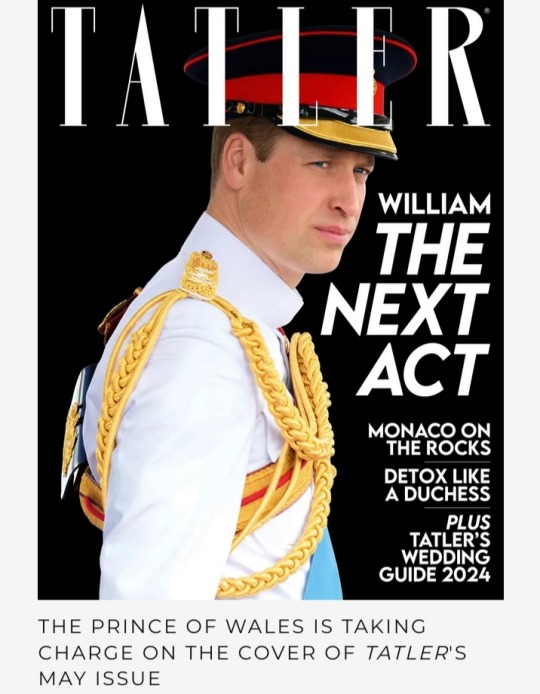
When I first met Prince William in 2009, he asked me if I could tell him how he could win the National Lottery.
It was a jokey quip from someone who has since become the Prince of Wales, the holder of three dukedoms, three earldoms, two baronies and two knighthoods, and heir to the most prestigious throne on earth.
He was, of course, being relatable; I was representing the organisation that had allocated Lottery funding towards the Whitechapel Gallery and he wanted to put me at ease.
William is grand but different, royal but real.
At 6ft 3in, he has the bearing and looks great in uniform after a distinguished, gallant military career.
He will be one of the tallest of Britain’s kings since Edward Longshanks in the 14th century and should one day be crowned sitting above the Stone of Scone that Edward ‘borrowed.’
William, by contrast, has a deep affinity with Scotland and Wales, having lived in both nations and gained solace from the Scottish landscape after his mother died.
He’s popular in America and understands that the Crown’s relationship to the Commonwealth must evolve.
The Prince of Wales has long believed that ‘the Royal Family has to modernise and develop as it goes along, and it has to stay relevant’, as he once said in an interview.
He seeks his own way of being relatable, of benefitting everybody, in the context of an ancient institution undergoing significant challenge and upheaval, as the head of a nation divided by hard times, conflicts abroad, and social and political uncertainty.
We might recognise Shakespeare’s powerful line spoken by Claudius in Hamlet: ‘When sorrows come, they come not single spies, but in battalions.’
With the triple announcement in January and February of the Princess of Wales’s abdominal surgery and long convalescence, of King Charles’s prostate procedure and then of his cancer diagnosis, the burden of leadership has fallen on 76-year-old Queen Camilla and, crucially, on William.

The Prince of Wales’s time has come to step up; and so he has deftly done.
In recent months, we have seen a fully-fledged deputy head of state putting into practice his long-held ideas, speaking out on the most contentious issue of the day and taking direct action on homelessness.
Last June, he unveiled the multi-agency Homewards initiative with the huge aspiration of ending homelessness, backed with £3 million from his Foundation to spearhead action across the UK.
He is consolidating Heads Together, the long-standing campaign on mental health, and fundraises for charities like London’s Air Ambulance Charity.
He was, of course, once a pilot for the East Anglian Air Ambulance services – a profession that had its downside: seeing people in extremis or at death’s door, he found himself ‘taking home people’s trauma, people’s sadness.’
Tom Cruise was a guest at the recent London’s Air Ambulance Charity fundraiser, William’s first gala event after Kate’s operation.
And more stardust followed when William showed that, even without his wife by his side, he could outclass any movie star at the Baftas.
There’s also his immense aim of helping to ‘repair the planet’ itself with his Earthshot Prize: five annual awards of £1 million for transformative environmental projects with worldwide application.
This project has a laser focus on biodiversity, better air quality, cleaner seas, reducing waste and combating climate change. Similar aims to his father; different means to achieve the goal.


On the issue which has caused huge convulsions – the Middle East conflict – William’s 20 February statement from Kensington Palace grabbed attention.
He said he was ‘deeply concerned about the terrible human cost of the conflict since the Hamas terrorist attack on 7 October. Too many have been killed.’
There were criticisms – along the lines of ‘the late Queen would have never spoken out like this’ or ‘what right does he have to meddle in politics?’ – but it was hard to disagree with his carefully calibrated words.
His call for peace, the ‘desperate need’ for humanitarian aid, the return of the hostages.
The statement was approved by His Majesty’s Government, likely cleared with the King himself at Sandringham the previous weekend and also backed by the chief rabbi of Great Britain, Sir Ephraim Mirvis.
Indeed, William and Catherine had immediately spoken out on the horrors of 7 October.
William followed up the week after his Kensington Palace statement by visiting a synagogue and sending a ‘powerful message’, according to the chief rabbi, by meeting a Holocaust survivor and condemning anti-Semitism.
This is rooted in deep personal conviction following William’s 2018 visit to Israel and the West Bank, says Valentine Low, the distinguished author of Courtiers and The Times’s royal correspondent of 15 years, who was on that 2018 trip.
‘William was so moved by his visit to Israel and the West Bank, he found it very affecting, and he was not going to drop this issue – he was going to pay attention to it for the rest of his life,’ says Low.
‘He must feel that… not to say something on the most important issue in the world [at that moment] would be a bit odd if you feel so strongly about it.’
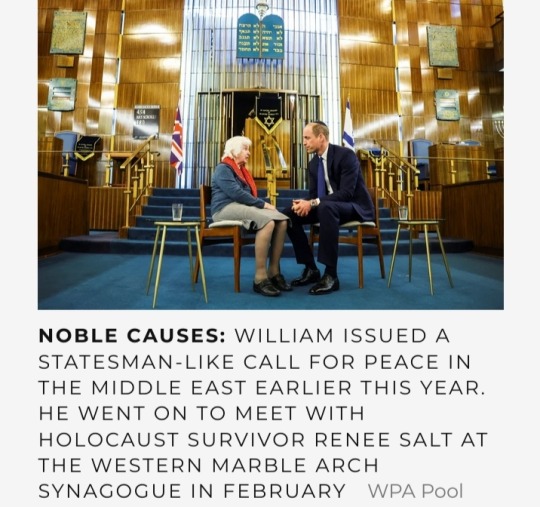
There was concern from some commentators about politicising the monarchy, but this rose above the particulars of party politics.
As Prince of Wales, like his father before him, there is perhaps space to speak out sparingly on carefully chosen issues.
On this occasion, his views were in line with majority public opinion.
On homelessness, news came that same week that William was planning to build 24 homes for the homeless on his Duchy of Cornwall estate.
‘William’s impact is very personal,’ says Mick Clarke, chief executive of The Passage, a charity providing emergency accommodation for London’s homeless.
‘Two weeks before Christmas, the prince came to our Resource Centre in Victoria for a Christmas lunch for 150 people.
He was scheduled to stay for an hour, to help serve, wash up, and talk to people.
He ended up staying for two and a quarter hours, during which time he went from table to table and spoke to every single person.’
Clarke continues:
‘William has an ability to listen, talk and to put people at ease. During the November 2020 lockdown, he came on three separate occasions to help.
It gave the team a boost that he took the time; it was his way of saying: “I support you; you’re doing a great job.”’
Seyi Obakin, chief executive of Centrepoint, one of the prince’s best-known causes, adds:
‘People associate his patronage with the big moments like the time he and I slept under Blackfriars Bridge.
The things that stick with me are smaller in scale and the more profound for it – in quieter moments, away from the cameras, where he has volunteered his time.’
It is a different approach from the King’s.
As Prince of Wales, he was involved in the minutiae of dozens of issues at any one time, working into the night to follow up on emails, crafting his speeches, writing or dictating notes.
Add to that much nationwide touring over 40 years (after he left active military service in 1976), fitting in multiple engagements, often being greeted formally by lord lieutenants.
This is not William’s style. He has commended his father’s model, but he does things his own way.
Although patronages are under review, William has up till now far fewer than either his father or his grandparents.
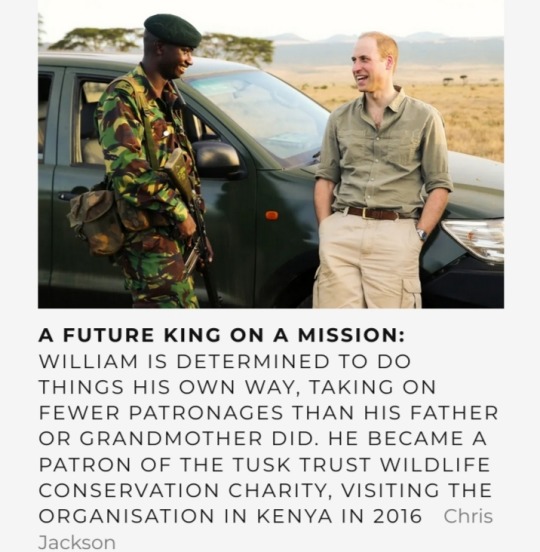
Charles is sympathetic to William’s approach and his desire to make time with his young family sacrosanct.
They are confidantes, attested by the night of Queen Elizabeth’s death.
They were both at Birkhall with Camilla, reviewing funeral arrangements while the rest of the grieving family were nearby at Balmoral, hosted by the Princess Royal.
Charles has had almost six decades in public life and is the senior statesman of our time, with even longer in the spotlight than Joe Biden.
After Eton and St Andrew’s University, where he met Catherine, William served in three branches of the military between 2006 and 2013, finishing as a seasoned and skilled helicopter rescue pilot.
His later employment as an air ambulance pilot stopped in 2017, when he became a full-time working royal.
At that time, not so long ago – with Harry unmarried, Andrew undisgraced, and Philip and Elizabeth still active – William shared the spotlight.
Now, after the King, he’s the key man.
He can look back on the success of his first big campaign initially launched with his wife and brother in 2016: Heads Together.
‘We are delighted that Prince William should have become such a positive and sympathetic advocate for mental health through his Heads Together initiative and now well-established text service, Shout, among other projects,’ says the longtime CEO and founder of Sane, the remarkable Marjorie Wallace CBE.
‘It is not always known that he follows in the footsteps of his father, the King, whose inspiration and vision were vital in the creation of our mental health charity Sane.
As founding patron, he was instrumental in establishing our 365-days-a-year helpline and was a remarkable and selfless support to me in setting up the Prince of Wales International Centre for Sane Research.’
'Indeed,' says Wallace, 'this is where Prince William echoes the work of his father, showing the same ‘understanding and compassion for people struggling through dark and difficult times of their lives and has done much to raise awareness and encourage those affected to speak out and seek help.
We owe a huge debt to His Majesty and the Prince of Wales for their involvement in this still-neglected area.’
Just as I saw all those years ago at that early solo engagement in Whitechapel, William still approaches his public duties with humour and fun.
‘He defuses the formality with jocularity,’ says Valentine Low, citing two public events in 2023 that he witnessed.
In April last year, while on a visit to Birmingham, William randomly answered the phone in an Indian restaurant he was being shown around and took a table booking from a customer – an endearing act of spontaneity.
On his arrival later that day, the unsuspecting diner was surprised to be told exactly whom he had been talking to.

In October, Low reported, William ‘unleashed his inner flirt as he hugged his way through a visit with Caribbean elders [in Cardiff] to mark Black History Month.
As he gave one woman a hug – for longer than she expected – he joked: “I draw the line at kissing.”
And while posing for a group photograph, he prompted gales of laughter when he quipped: “Who is pinching my bottom?”’
Low believes that when William eventually becomes king, he will be more ‘radical’ than his father but wonders if people will respond to ‘call me William’ when ‘the whole point of the Royal Family is mystique and being different.’
However, William has thought deeply about his current role and is prepared for whatever his future holds.
For now, there is a decision to be made on Prince George’s secondary schooling. It’s said that five public schools are being considered, all fee-paying.
Eton is single-sex and boarding but close to home. Marlborough (Catherine’s alma mater) is co-ed and full boarding. And Oundle, St Edward’s Oxford and Bradfield College (close to Kate’s parents) are co-ed with a mix of boarding and day.
As parents, William and Catherine aspire to raise their children ‘as good people with the idea of service and duty to others as very important’, William said in an interview with the BBC in 2016.
‘Within our family unit, we are a normal family.’ Which may be one reason why he is so resistant to their privacy being compromised either by the media or close family members.

The 19th-century author Walter Bagehot wrote:
‘A family on the throne is an interesting idea also. It brings down the pride of sovereignty to the level of petty life… a princely marriage is the brilliant edition of a universal fact, and, as such, it rivets mankind.’
If hereditary monarchy is to survive, it must beguile us but also demonstrate its utility, that it is a force for good.
William said in that 2016 interview, ‘I’m going to get plenty of criticism over my lifetime,’ echoing Queen Elizabeth II’s famous Guildhall speech in 1992 ‘that criticism is good for people and institutions that are part of public life. No institution – city, monarchy, whatever – should expect to be free from the scrutiny of those who give it their loyalty and support, not to mention those who don’t.’
William saw close up his mother’s ability to bring public focus and her own personal magnetism to any subject or cause she focused on.
He admires his father’s work ethic, the way he ‘really digs down,’ sometimes literally (I understand that gardening is giving the King solace during his cancer treatment).
But the biggest influence for William was Her late Majesty, as he said on her 90th birthday.
As an Eton schoolboy, William made weekend visits to the big house on the hill, being mentored by Granny rather as she had been tutored in the Second World War by the then vice-provost of Eton, Sir Henry Marten.
William said in 2016:
‘In the Queen, I have an extraordinary example of somebody who’s done an enormous amount of good and she’s probably the best role model I could have.’
That said, his aim was ‘finding your own path but with very good examples and guidance around you to support you.'

Queen Elizabeth II had a brilliant way of rising above the fray and usually being either a step ahead of public opinion or in tune with it.
If you are at the helm of affairs in a privileged hereditary position, your duty is to serve and use your pulpit for the benefit of others.
In a democracy, monarchy is accountable.
The scrutiny is intense, with an army of commentators paid for wisdom and hot air about each no-show, parsing each announcement, interpreting each image.
William takes the long view. He has ‘wide horizons,’ says Mick Clarke.
‘There are so many causes that are more palatable and easier to achieve than ending homelessness, but his commitment and drive are 100 per cent.’
The prince seeks a different way of being royal in an ancient institution that must move with the times. His task? To develop something modern in an ever-changing world.
He faces all sorts of new issues – or old issues in new guises.
Noises off from within the family don’t help – Andrew’s difficulties, or the suggestions of prejudice from Montecito a couple of years ago (now seemingly withdrawn), which prompted William’s most vehement soundbite: ‘We’re very much not a racist family.’
William is maybe a new kind of leader who can keep the monarchy relevant and resonant in the coming decades.
Queen Elizabeth II is a powerful exemplar and memory, but she was of her time. William is his own man.
He must overcome and think beyond ‘the unforgiving minute.’
Indeed, he could seek inspiration in Rudyard Kipling’s poem, If.
If you can force your heart and nerve and sinew
To serve your turn long after they are gone,
And so hold on when there is nothing in you
Except the Will which says to them: ‘Hold on!’
If you can talk with crowds and keep your virtue,
Or walk with Kings—nor lose the common touch[…]
Yours is the Earth and everything that’s in it,
And—which is more—you’ll be a Man, my son!

This article was first published in the May 2024 issue, on sale Thursday, 28 March.
#Prince William#Prince of Wales#British Royal Family#Wesley Kerr OBE#Edward Longshanks#Homewards#Heads Together#London’s Air Ambulance Charity#East Anglian Air Ambulance#Tom Cruise#BAFTAS#Earthshot Prize#Kensington Palace#King Charles III#Sir Ephraim Mirvis#Valentine Low#Duchy of Cornwall estate#The Passage#Centrepoint#Birkhall#Sane#Marjorie Wallace CBE#Shout#Balmoral#Prince George#Walter Bagehot#Sir Henry Marten#Rudyard Kipling#If
146 notes
·
View notes
Text
Insect populations flourish in the restored habitats of solar energy facilities
Pairing solar energy facilities on previously disturbed lands with habitat enhancement sounds like a logical win-win strategy to address energy and biodiversity challenges.
103 notes
·
View notes
Text
To my folks who experience climate grief:
Over the last few days I've been obsessed with a game called Half Earth Socialism:

[ID: opening screen for the game Half Earth Socialism. From top to bottom: there's an image of the earth encircled in a design that looks like wrapped wheat. Both are colored pink. The title of the game is below, along with the tagline "A Planetary Crisis Planning Game." Under that, there is a menu with options for New Game, Sound toggle off or on, and Credits. There is a hyperlink at the very bottom that says "Read the book: Half-Earth Socialism." end ID]
The game was created by Drew Pendergrass andTroy Vettesse, the authors of the book Half-Earth Socialism: A Plan to Save the Future from Extinction, Climate Change and Pandemics. I read the book last year, but didn't play the game until recently.
The premise is that a socialist revolution sweeps the world, and you play as a lead planner who must 1) lower emissions and therefore the temperature below 1ºC, 2) reduce the rate of biodiversity loss, 3) keep people around the world happy, 4) use political capital to implement policies and gain allies in parliament, and 5) avoid production shortages of electricity, fuel, and food.
It's very challenging to beat the game because of all those factors. Sometimes I'd do well in one planning stage on some of those areas but fail in others, and they all have an impact on your political capital and public approval. Seeing headlines within the game about environmental disasters, species extinction, pandemics, etc. if I wasn't doing well was really upsetting. In the first planning stage of the game, they're inevitable because your plans can take many in-game years to actually start improving things. I found myself skipping those after a time. But, as I figured out the mechanics and how and when and in what combinations to prioritize policies, I felt excited about headlines like "polinators are flourishing," "people are making their own gardens," "the quality of life in the Global South is improving." I finally got to the best win state earlier today after trying one or two dozen times.
Aside from lifting my mood and sense of hope, I also learned a lot about proposed and existing technologies meant to address climate change: biochar, carbon capture, electric grids, energy quotas, etc. Also, it helped me feel impactful, even though I knew it was just a game. For example, one of the policies I tended to implement in the first planning cycle was granting indigenous sovereignty. I loved being able to do that in basically one fell swoop.
Even when I had critiques of the game, I found those meaningful because I started thinking about points the developers missed and what else would be needed to create a just transition. That's super important because no one person is going to think of everything.
Obviously, your capabilities and decision making processes in the game are oversimplified for the point of educating and simulating. And the game reflects certain biases of the developers. For example, the idea of one central body organizing every policy and process in the world, with most of the decisions coming from one person, does not sound to me like it would work well. Even so, I think instilling that sense of capability is so important, especially since so many everyday people feel defeated and like they can't change anything right now.
Suffice it to say, I enjoyed this game, and I recommend it highly! The game is in English, Spanish, and Portuguese (Brazilian and from Portugal).
#long post#games#video games#climate change#climate grief#simulation#half-earth socialism#half-earth
315 notes
·
View notes
Text
What Kind of Plants to Add
This is my sixth post in a series I’ll be making on how to increase biodiversity on a budget! I’m not an expert–just an enthusiast–but I hope something you find here helps!
I’d love to be able to give a quick and easy list of things to add, but frankly I can’t do that. I can strongly encourage you, however, to look at these categories of plants and do further research to discover what’s native to your area, so you can plant things that’ll have the most impact in your particular area.
With that being said, I will mention a few plants as examples. This is in no way, shape, or form me telling you that you have to or even should buy these specific plants. Not every plant works well in every place in every garden, not to even mention across countries. Above all, if you’re wondering what plants you should be adding, I can wholeheartedly say plants that are native to your area--or at least nonnative non-invasive.
Flowers
Flowers are some of the most common ways people work to increase biodiversity in their gardens, and who can blame them? Seeing pops of color out your window, and directly seeing the impact via butterflies and bees visiting the garden? It’s a win-win for us and the wildlife!

Flowers--especially native wildflowers--are a quick, easy, and cheap way to increase wildlife traffic in your garden. Perennial gardens are more likely to get you the most bang for your buck, as they’ll come back year after year if you treat them well. But don’t dismiss annuals--if you get ones that easily reseed, they’ll eagerly return on their own! If you can, do your best to ensure that the flowers you plant all have different blooming periods--that way, your garden can support wildlife throughout the year instead of for just one brief season.
Flowers are environmental super boosters. Their nectar and pollen can feed insects and birds, their stems and leaves can provide nesting materials for all sorts of creatures, and their seeds are a popular food source among birds at all times of the year.
Climbing Plants
Climbing plants can be fantastic options for maximizing your impact. If you have limited ground space, growing up can provide interest as well as additional habitat for all kinds of creatures.

Training plants up a trellis, fence, or bare wall offers food, shelter, and habitat. Trumpet vines, passionflowers, honeysuckles, and more will provide sweet nectar for pollinators as well as nesting and hiding spaces for other wildlife like birds, bugs, and lizards. Do note that in some cases, climbing plants can actually affect the structural integrity of walls and roofs if allowed to climb too much and too far along a house, so be careful.
Bushes/Shrubs
Bushes provide shelter for creatures, which then provides hunting grounds for other animals. Their fallen leaves and petals can be food and shelter for detritivores, amphibians, reptiles, and small mammals--and they also provide good cover for moving around the garden, for creatures who like to stay hidden. They can be a bit more pricey to obtain--unless you get cuttings or seeds and are willing to wait--but they’ll definitely be worth it, and they’re typically low-maintenance once they’re established.

Bonus points if you get a flowering and fruiting bush, like bottlebrush, serviceberry, lilac, or others. This’ll make your bushes not only a place of shelter, but a food source as well--and depending on the kind you pick, may be food for you too! Making a garden border with a series of bushes can be a great option to providing lots of habitat, if you can manage it.
Shrubs with pithy or hollow stems are excellent options for supporting solitary bees. Some examples you could look into are elderberry, raspberry, blackberry, or sumac.
Trees
Trees have a high up-front cost and take awhile to grow, but once they’re settled in place they provide crucial habitat to all kinds of creatures! Insects will be attracted to flowers they may provide, or to nest in the wood. Others may eat the leaves as food, or use them as nesting materials. Birds will perch and nest in trees, and feed off the fruits and seeds and insects that also use the tree. Squirrels also use trees as nesting places, piling up dead leaves into huge clusters to raise their young in, and will absolutely feast on any nuts the tree may provide. Mice, badgers, and more will feast on fallen fruits or seeds, and bats roost in the trunks when given the chance. Detritivores eat fallen leaves and decomposing fruits, providing further food for hunting creatures. Trees can also be good for us--they help block out noise and air pollution, and are the poster child for taking CO2 and making it breathable oxygen. Not to mention they can provide plenty of food for us, too. Nesting grounds, hunting grounds, shelter from weather, and more--trees are, in my opinion, likely to be the best way to boost biodiversity long-term. If you can get your hands on a sapling for cheap and can care for it for awhile, I’d definitely give it a shot! Make sure the tree won’t get too big for where you’re growing it, though--you’ve definitely gotta plan for the long-term before you plant any.
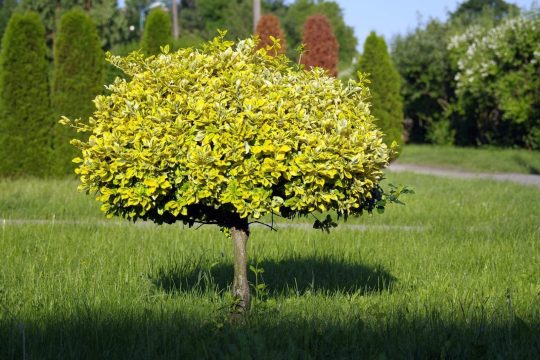
Some trees can be grown in containers. Though they won’t become gigantic branching behemoths, they’ll still do their part to support all the life that depends on them. Growing a tree from seed may take awhile, but could be an easy option to getting one if you have the patience--the trees are more than happy to help you, as they drop tons of seeds and fruit in fall for you to gather.
Groundcover
Bare soil is the enemy of microbial life in the soil, and while small pockets of bare soil can be great nesting places for bees and other insects, having swaths of empty soil should be avoided. Groundcover plants grow low to the ground in a sprawling habit, and will often spread quite easily on their own. This is a great way to provide shelter, keep soil temperatures cool, block out weeds, and give your soil life a chance to thrive.

Sometimes, ground covers don’t even have to be planted in the ground. Shallow-rooted plants like succulents, ferns, and alyssum can be planted into cracks in stone walls, and moss can be planted by making moss graffiti and painting it onto a surface. As with climbing plants, do make sure that you don’t cause extra damage to important walls and housing foundations.
Host Plants
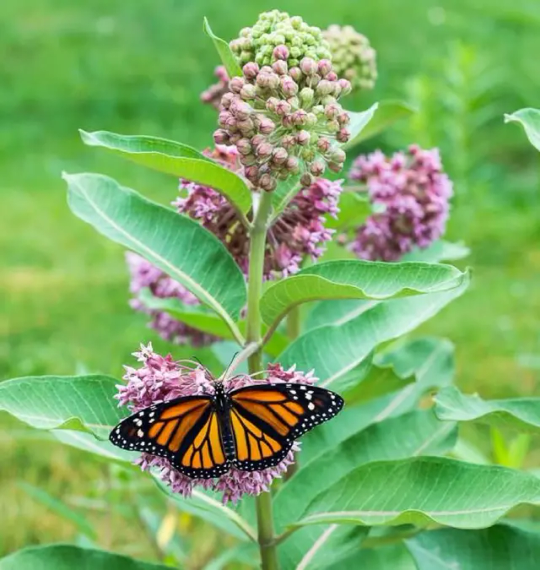
Host plants get their own section, because plants of all kinds can be host plants for different creatures! It’s common to think only flowers can be host plants in the beginning, but in reality, many bushes and trees are host plants to dozens of species of butterflies and moths. Honestly, I feel that factor's not talked about enough. Look up what insects live in your area and what kind of host plants they need, and plant some if you can! Bonus points if you can plant a variety of them--I know that there’s hundreds of kinds of milkweed, each one flowering and leafing up around different times of the year. Planting several varieties of milkweed, then, would provide monarchs with food through several seasons, allowing many more of them to grow up in your garden!
Nectar Plants
Plants that provide nectar to insects is a great foundation to increasing biodiversity! This is, of course, many native wildflowers (and even nonnative wildflowers, though be sure they aren’t invasives who’ll do more harm than good), but many native bushes, vines, and trees will also provide nectar to hungry pollinators!
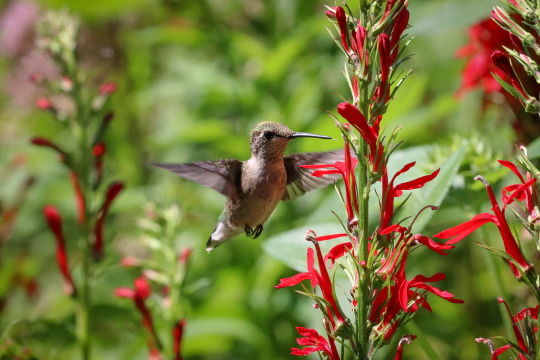
Keystone Species
To be frank, some plants can have a bigger impact than others in a landscape. By all means, every bit helps, but if you want to boost biodiversity quickly there are a few plants that can essentially serve as the backbone of local ecosystems that you can grow in anything from a balcony pot to a small patch of your backyard. These plants can be different depending on where you are, so do your research to find out what would be best to grow in your area. If you can’t get them all? That’s alright! But even hitting just a few of these target species really can do a lot.

That’s the end of this post! My next post is gonna be about things to keep in mind/continue to do once you get plants in the ground! Until then, I hope this advice was helpful! Feel free to reply with any questions, your success stories, or anything you think I may have forgotten to add in!
#biodiversity#solarpunk#gardening#outdoor gardening#ani rambles#out of queue#the biodiversity saga#sorry its been 2 months since I last posted to this series#I literally have everything drafted out I just got Busy because maannnnnnn animating a grad school capstone project all by yourself....#i should really start using my youtube channel to post my animations but they never feel Done so I just Dont#i dont have as many links in this one because... they weren't in the draft and any tumblr posts that came to mind I couldn't hunt down#either way i hope this was Helpful and Lit and All That Jazz#I might just post the other parts tomorrow so I can stop having that hanging over my head#and so I can get my sources masterpost out there so people can like. see I'm trying my best not to just talk out of my ass#anyways see yall
157 notes
·
View notes
Text
Biodiversity win! my dad convinced my neighbor to plant some trees
298 notes
·
View notes
Text
Am I a little bit late for some of you? I might be. But anyways. Here's what went right around the world this past week :)
Youth climate activists won a huge climate lawsuit
Sixteens youths (aged five to 22) from Montana, US, have emerged victorious after suing state officials for violating their right to a clean environment.
In their lawsuit, they argued that Montana's fossil fuel policies contributed to climate change, which harms their physical and mental health. Montana is a major coal producer, with large oil and gas reserves. The state has rebuffed these claims, saying that their emissions were insignificant on a global scale.
Judge Kathy Seely, in a 103-page ruling, set a legal precedent for young people’s rights to a safe climate by finding in their favour. “Every additional tonne of GHG [greenhouse gas] emissions exacerbates plaintiffs’ injuries and risks locking in irreversible climate injuries".
This win marks the very first time a US court has ruled against a government for a violation of constitutional rights based on climate change. It will now be up to Montana lawmakers to bring state policies in line.
“As fires rage in the west, fueled by fossil fuel pollution, today’s ruling in Montana is a gamechanger that marks a turning point in this generation’s efforts to save the planet from the devastating effects of human-caused climate chaos.” - Julia Olson, executive director of nonprofit law firm, Our Children’s Trust, which represented the youths in this case.
Number of Mexicans living in poverty fell by millions
Thanks to a new minimum wage boost and increases to pensions, the number of Mexicans living in poverty fell by 8.9 million between 2020-2022, according to new data published by the country’s social development agency, Coneval.
Coneval’s statistics suggest that the number of people living in extreme poverty also fell – from 10.8 million in 2020 to 9.1 million last year – although that figure is still up from a pre-Covid 8.7 million recorded in 2018.
There is still a long way to go, and some critics do claim that during the current president, López Obrador's presidency has been characterized by austerity.
An organised crime group trafficking endangered species has been jailed
The Wildlife Justice Commission (WJC), a small European wildlife charity, is apparently busting kingpins behind as much as half of the world's illegal trade in pangolin scales. The traffickers began six-year jail sentences a few weeks ago.
The wildlife charity went undercover to expose three Vietnamese and one Guinean national, members of an organised crime group trafficking body parts of endangered species including rhinos.
They were arrested in May 2022, following a four-year investigation by the WJC, and were accused of trafficking 7.1 tonnes of pangolin scales, as well as 850kg of ivory. Last month they pleaded guilty to smuggling and were jailed for six years.
All eight species of pangolin are listed as threatened animals, four critically endangered - they are protected by international law.
“There has not been a reported seizure of pangolin scales in Asia originating from Africa in more than 550 days,” said Steve Carmody, WJC’s director of programmes. “There is no clearer example of the importance of disrupting organised crime networks.”
AI gave conservationists a breakthrough
The use of AI-controlled microphones and cameras seems set to revolutionise
biodiversity monitoring in the UK following groundbreaking work by researchers at the Zoological Society of London (ZSL). They used the tech to record and analyse 3,000 hours of wildlife audio captured by monitors located near London railway lines.
The computers detected dozens of bird species, foxes, deer, bats and hedgehogs, and mapped their locations.
It’s hoped the innovation will help improve conservation and habitat management on Network Rail land.
This year is best ever for UK renewable energy installations
This years looks to be the best year so far for UK renewable energy installations, with record numbers of households fitting solar panels and heat pumps.
2023 marks the first time solar panel installations have topped an average of 20,000 a month, as homeowners look to harvest energy from the sun amid rising utility bills.
Read the full story here.
The UK’s Tree of the Year shortlist was revealed
The Woodland Trust has announced the shortlist for its annual celebration of some of the UK’s most treasured ancient trees, and for 2023 the spotlight is on the urban landscape.
“Ancient trees in towns and cities are vital for the health of nature, people and planet,” said the charity’s lead campaigner Naomi Tilley. “They give thousands of urban wildlife species essential life support, boost the UK’s biodiversity and bring countless health and wellbeing benefits to communities.”
Article published August 17, 2023
Thank you so much for reading! Let me know what interested you, and if there's any specific topic you'd like me to dig into, my DM's are always open :)
Much love!
#climate change#climate#hope#good news#more to come#climate emergency#news#climate justice#hopeful#positive news
112 notes
·
View notes
Text
Ms Wütrich, who is a specialist in forest diversity, believes the Swiss cull is "unprecedented in Europe".
She says wolves are integral to maintaining biodiversity, especially by preying on deer which damage forests by destroying young trees: "In certain areas the deer are actually responsible for changing the species composition of the forests."
48 notes
·
View notes
Note
How would anarchists deal with Climate change?
This does include: How would they communicate it to everyone; how would *enough people* *comply enough* to stop/reverse the effects?
What type of polution would remain?
The thing you have to be conscious of is that the most significant impacts of climate change are really not about individuals. The shift of focus from the big polluters to individuals, more often than not the poor, was a targeted and co-ordinated campaign that was designed to take building heat off polluting companies. And it worked. It worked because the idea that we can’t (and shouldn’t) change systemic conditions and that we should individualise our problems and work only on our own relationship with climate change and pollution sits well with the individualist metanarrative of liberal capitalism. Don’t get me wrong, there’s lots of things we can personally do to help the environment, but the real blows to carbon emissions and pollution will come from systemic change.
So a lot of the factors driving climate change would be eliminated in an anarchist society. Capitalist overproduction would be curtailed because there’s no currency- people get what they need when they need it. So waste is drastically reduced, reducing pollution and carbon emissions.
Because there’s no profit motive, and no need for overproduction nor driving factors for overconsumption. Industries don’t have to curtail environmental provisions for their production methods, and instead they can even make it their focus to produce goods sustainably; after all, literally why not?
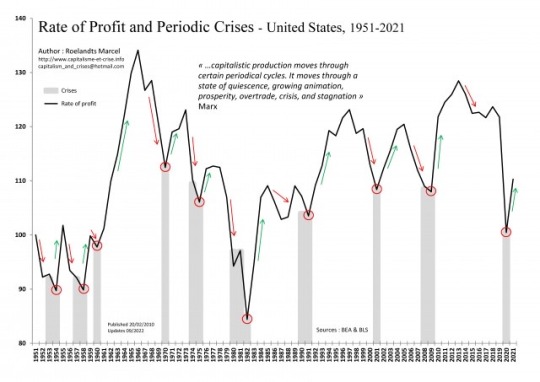
Communitarian organisation has an inherent lean to reducing reliance on cars and focusing on public transport, so car emissions would be reduced (it would simply be more convenient to use the vastly improved public transport network!).
There’s no need for a lot of the factors driving food waste, so agricultural land can be repurposed into natural reserves. I think around 50% of the food produced in America goes to waste. Think about what you could do to reconstitute the American prairie, European Forests, and Jungles across the world if we co-ordinated a reduction in food waste like that. Think about the biodiversity we could win back. All of these environments are huge carbon sinks in their own right. Agriculture produces a huge amount of greenhouse gases. And we don’t need nearly as much as we have! Those hunger/famine/starvation crises we hear about? They’re necessary to the function of capitalism. They’re crises of poverty. They’re crises of market exclusivity.
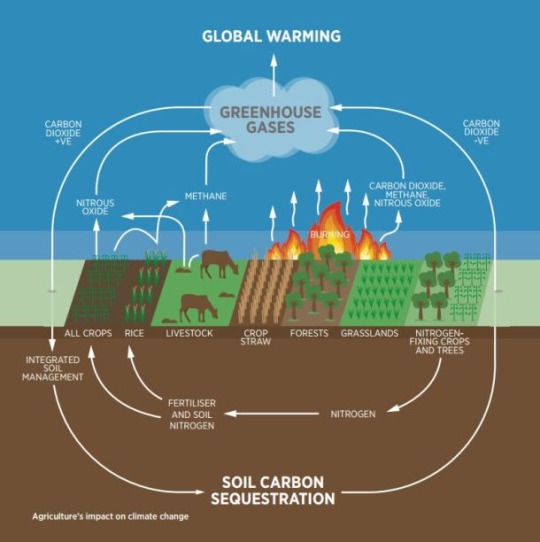
Have no doubt about it. Climate change is an inevitable consequence of Late Stage Capitalism. I believe the drastic impacts of climate change we are going to see in the coming decades are what will eventually bring about its end. It’s up to us to make sure that the system that rises from the ashes is one that is better for all.
#anarchism#anarchist#anarchocommunism#praxis#communism#communist#revolution#leftism#leftist#politics#enviromental#environmentalism#eco#ecology#climate science#climate change#climate crisis
106 notes
·
View notes
Text
The people of Panama are coming together to defend nature, calling on the country’s Supreme Court to declare a controversial mining project – in the protected rainforest Bosque Donoso – as unconstitutional.
This area, lying in the heart of the largest biological corridor in Mesoamerica, is a lifeline for many migratory species. It is critical to the livelihoods and cultures of local and Indigenous communities, and is home to wildlife that includes macaws, tapirs, monkeys and jaguars. This mining activity would have destructive impacts on the surrounding ecosystems, species, and people.
A global spotlight can help Panamanians win a critical victory for biodiversity and can pave the way for a more sustainable future.
Sign the petition to halt the mining project in Panama at this link: https://chng.it/dMzbJSxv7v
#PanamaTeQuieroVerde #PanamáValeMásSinMinería
Video credits:
Collaboration between @duletvindigena @waguafilms @mullu.tv & Passu Creative Community
Narrated by @rosedelizg
Cover photo by @enlayesk507
#panama#central america#latin america#abya yala#environmental justice#climate justice#ecology#anti imperialism#extractivism#neocolonialism#anti colonialism#indigenous rights#signal boost
252 notes
·
View notes
Text
Doctor Agatha Shiny

Image © @iguanodont
[Writing this entry was very cathartic. Doctor Shiny is not only my Villain OC (and trust me, there's nothing even remotely redeeming about her), but also a way to process the trauma I experienced in grad school. You may have noticed that "collegial mad scientists" are a recurring theme in my work; Doctor Shiny is their boss in the Inner Sea, at least as far as mere mortals go. I’ve been meaning to create a Legion of Doom in my campaigns, and this is as good an excuse as I’m likely to get. As one of the most powerful alchemists on Golarion, I gave Doctor Shiny access to a ton of weird extracts; I'm just posting a link to the Archives of Nethys master list than linking to them individually.
Also? Without any visual reference, Iguanodont managed to make Doctor Shiny look an awful lot like me. Spooky.]
Doctor Agatha Shiny
CR 20 NE Humanoid
This woman is fat and cheerful, her brown hair done up in a messy ponytail. She is dressed in a lab coat, heavy gloves and boots. Two tentacles grow from her back, each studded with sightless eyes.
Everyone in Absalom knows who Doctor Agatha Shiny is; she’s a celebrity scientist. Head of the Biology Department at Endiron School in Eastgate, her lectures on everything from diet to material science to biodiversity are popular and well attended by the public for entertainment and education purposes. Her column, “Ask Doctor Shiny”, is carried by several broadsheets and circulations. “Ask Doctor Shiny” is a slang phrase in Absalom meaning roughly, “how should I know?” Her various grad students and colleagues have nothing but nice things to say about her. Because the ones who talk out of turn have a habit of ending up dead or transformed.
Despite her jolly exterior, Doctor Shiny is a sadist of the highest caliber, and someone who is disgusted with humanity in general. It is her studied opinion that humans have been the dominant species on Golarion for far too long, and the ultimate aim of her research is to find a suitable replacement. Her primary laboratory for these experiments is the Puddles, which is increasingly home to murderous monsters of her own design. Doctor Shiny and the headmaster of her college, Tontartigan Dellby, have a system of mutual blackmail; both knows the broad strokes of each other’s schemes, enough to expose and humiliate the other if pushed. Agatha knows that she would win any conflict if it were to arise—she would merely shred Dellby with her bare hands and replace him with a simulacrum that obeyed her every command.
Doctor Shiny’s main lab is underground at Endiron School, but she maintains laboratories throughout Absalom and the entire Inner Sea region, each one of which has a doppelganger simulacrum she can project her mind into. Each lab is a facility for collecting monsters from the region, running tests on their physical and magical properties, and incorporating their characteristics into fleshwarped abominations. Her raw materials for fleshwarping often include those aforementioned recalcitrant students, as well as indigents, adventurers and other people who go unmissed. Those that would be missed are replaced with simulacra, or turned into dominated sleeper agents. Doctor Shiny has done some self-experimentation; tentacles grow from her back (she keeps these under her lab coat in her role as a public figure), and her internal organs are no longer fully human.
Like any good scientist, Doctor Shiny maintains a network of colleagues, almost all of whom are just as depraved as she is. Her Number One Minion is a blue slaad named Ranna, who was once a graduate student named Marina Rhinne, and to most of the world is still known by that name and identity. Ranna serves Doctor Shiny as an assassin, collection agent and lover. Doctor Shiny was the first contact point in Absalom for a species of fleshwarping monsters from Sarusan who have decided that the Inner Sea is ripe for their exploitation—these are the zern. She is also the chair of CIS, the Committee for Ingenious Science. CIS is a network of mad scientists throughout Avistan and Garund who occasionally report on their findings and brainstorm new ways to exert their will on the world. And lastly, Agatha Shiny is a religious woman. Her primary deity is Shub Nugganoth, but she sees the Goat of the Woods as the leader of a small pantheon of gods and demigods devoted to nightmares of evolution and knowledge at any cost. These six deities are the kyton demagogue Raetorgash, the sahkil tormentor The Vermillion Mother, the daemonic harbinger Deceid, the demon lord Abraxas, Shub Nugganoth and her green (wo)man daughter, Briarpatch. Doctor Shiny refers to these six as the Xammux, a zern word meaning “council”.
New Material: Shoggomer
Shoggomer is one of Doctor Shiny’s miscellaneous inventions, although she typically refers to it as “self repairing polymer” in public. It is a form of latex, made with both tree sap and fleshwarping reagents derived from shoggoth ichor. Shoggomer can be used to make clothing, or any form of armor typically made from leather, hide or fur. As it is flexible, it cannot be used to make shields or typically metal armors. Shoggomer armor reduces its spell failure chance by 10%, increases max Dexterity bonuses by 2, and decreases armor check penalties by 2. Materials made of shoggomer heal at a rate of 2 hit points per day, or 1 per day if they have the broken condition. While healing, shoggomer materials manifest sightless eyes, small mouths or small flapping tendrils—this both institutes an armor check penalty of 2 when worn, and creatures within 30 feet must succeed a DC 15 Will save or be shaken for 1 minute by the eerie sight. A creature is only affected by the fear effect of repairing shoggomer once in a 24 hour period, whether it succeeds or fails the save. Shoggomer items are always of masterwork quality
Type of Shoggomer Item Item Price Modifier
Clothing +750 gp
Light armor +1000 gp
Medium armor +1500 gp
Other items +450 gp/pound
Doctor Agatha Shiny CR 20
XP 307,200
NE Medium humanoid (human)
Human alchemist (clone master) 20
Init +7; Senses Perception +23; true seeing
Defense
AC 31, touch 18, flat-footed 28 (+3 Dex, +5 deflection, +5 natural, +8 armor)
hp 273 (20d8+180); fast healing 5
Fort +26, Ref +21, Will +14; +4 vs. poison
Immune alignment and thought detection
Defensive Abilities fortification (25%)
Offense
Speed 40 ft.
Melee spirit blade +23/+18/+13 (1d4+7 plus 1d6 acid/19-20), 2 tentacles +23 (1d4+7)
Ranged +1 seeking light crossbow +20 (1d8+1/19-20) or bombs +19/+14/+9 touch (10d4+10 fire)
Extracts Prepared CL 20th
6th—beast shape IV, caging bomb admixture, heal (x2), monstrous physique IV, transformation, verminous transformation
5th—dream, greater claim identity (DC 25), overland flight, planar adaptation, simulacrum, spell resistance, undead anatomy II
4th—caustic blood (DC 24), cure critical wounds, death ward, enchantment foil, fluid form, freedom of movement, restoration, touch of slime (DC 24)
3rd—absorb toxicity (DC 23), arcane sight, countless eyes, displacement, dragon turtle shell, heroism, protection from energy, voluminous vocabulary
2nd—animal aspect, delay poison, false life, invisibility, lesser restoration, spider climb, venomous bite, vine strike (DC 22)
1st—anticipate peril, bomber’s eye, cure light wounds, disguise self, polypurpose panacea, shield (x2), targeted bomb admixture
Special Attacks bombs (30/day, DC 30), mutagen (+8/+6/+4 ability scores, +6 natural armor)
Statistics
Str 18, Dex 16, Con 26, Int 30, Wis 14, Cha 20
Feats Craft Construct (B), Craft Wondrous Item, Extra Discovery (x2), Fleshwarper, Improved Initiative, Magical Aptitude, Master Craftsman (Craft: alchemy), Multiattack, Point Blank Shot, Power Attack, Precise Shot
Skills Bluff +24, Craft (alchemy) +37, Diplomacy +26, Disable Device +31, Disguise +26, Fly +21, Heal +25, Knowledge (arcana, nature) +31, Knowledge (dungeoneering, local, planes) +28, Linguistics +18, Perception +23, Perform (oratory) +26, Spellcraft +31, Survival +23, Use Magic Device +30
Languages Aboleth, Abyssal, Aklo, Common, Daemonic, Draconic, Gnoll, Infernal, Kelesh, Orisian, Senzar, Slaad, Sylvan, Thassilonian, Undercommon, Varisian, Zern
SQ alchemy, discoveries (alchemical simulacrum, doppelganger simulacrum, fast bombs, fast healing, feral mutagen, greater mutagen, grand mutagen, infusion, preserve organs, promethean disciple, sleeper agent, tanglefoot bomb, tentacle [x2]), instant alchemy, legendary, persistent mutagen, poison use, rebirth, swift poison
Gear manual of gainful exercise +5 (expended), tome of clear thought +4 (expended), headband of mental superiority +6 (Diplomacy, Disguise, Perform (oratory), belt of physical perfection +4, +5 shoggomer studded leather armor of improved electricity resistance, spirit blade, +1 seeking light crossbow, vest of the ultimate alchemist (counts as greater poisoner’s jacket, vest of stable mutation and vest of surgery), amulet of natural armor +5/mighty fists +5, truesight goggles, deliquescent/poisoner’s gloves, charlatan’s lab coat of resistance +5, ring of protection +5, ring of mind shielding and sustenance, boots of striding and springing, boro beads (1 4th level, 2 3rd level, 2 1st level), cauldron of brewing, pale green ioun stone, scroll of greater teleport (x3), 20 bolts, 100,000 gp worth of alchemical reagents and poisons, alchemist’s lab, formula book (as prepared, plus true seeing, clone, greater invisibility, eyes of the void, neutralize poison, stoneskin, claim identity, lesser simulacra, nondetection, water breathing, barkskin, bear’s endurance, blur, bull’s strength, cat’s grace, eagle’s splendor, fox’s cunning, owl’s wisdom, undetectable alignment, crafter’s fortune, identify, touch of the sea), 645 gp.
Special Abilities
Legendary (Ex) Doctor Shiny’s statistics are built on 25 point buy and she has the gear of a 20th level PC. These advantages increase her CR by +1
Mutagen (Su) Doctor Shiny’s mutagens are built to grant her a +8 bonus to Strength, +6 to Constitution and +4 to Dexterity. With her mutagen (and her vest of the ultimate alchemist), her statistics are as follows:
Init +9; AC 39, touch 20, flat-footed 35; hp 333; Fort +29, Ref +23; Melee spirit blade +27/+22/+17 (1d4+11 plus 1d6 acid/19-20), claw +26 (1d6+9 plus 1d6 acid), bite +26 (1d8+9), 2 tentacles +26 (1d4+9); Str 26, Dex 20, Con 32; Skills Fly +23
#doctor shiny#alchemist#pathfinder 1e#pathfinder rpg#monster girl summer#npc#age of monsters#age of monsters spoilers#body horror#mad scientist#transformation#cthulhu mythos#shub nugganoth
83 notes
·
View notes